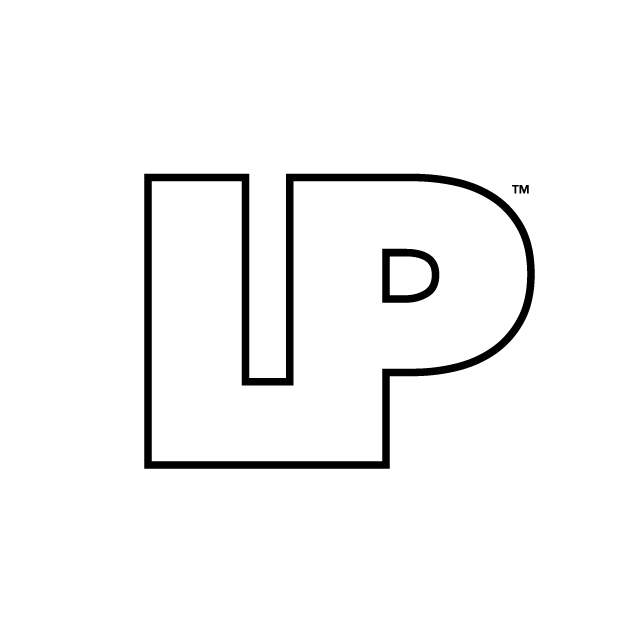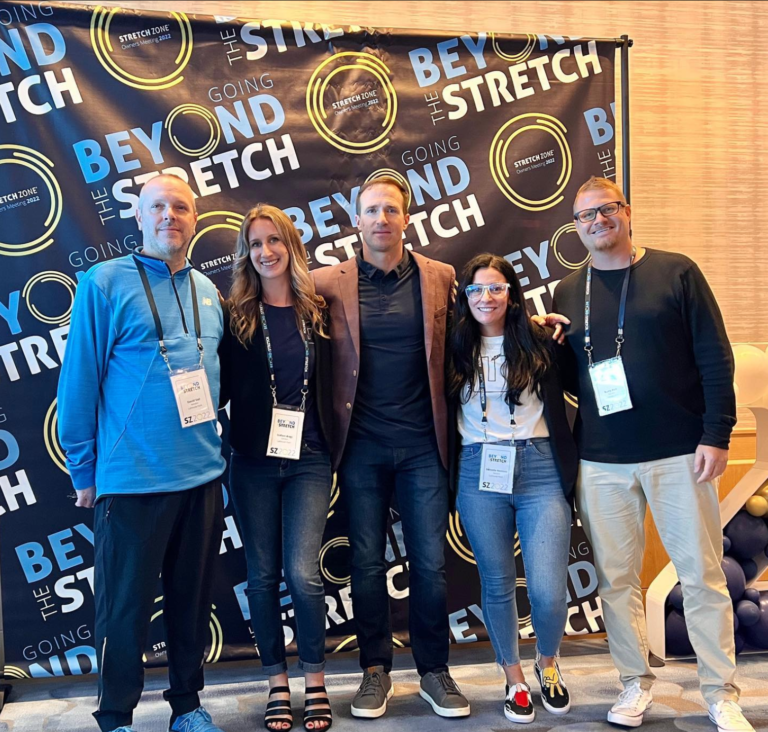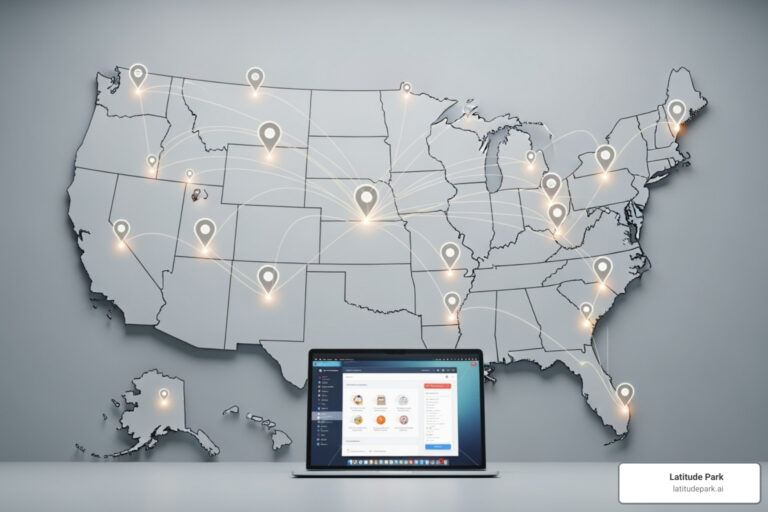Think of a digital content strategy as the master plan for your brand's voice. It's the high-level thinking that decides why you're creating content, who you're creating it for, and how it’s going to help your business grow.
This strategy is the blueprint that makes sure every single blog post, video, or social media update has a clear purpose. It’s what turns random acts of content into a powerful, predictable engine for growth.
The Blueprint for Your Brand’s Success
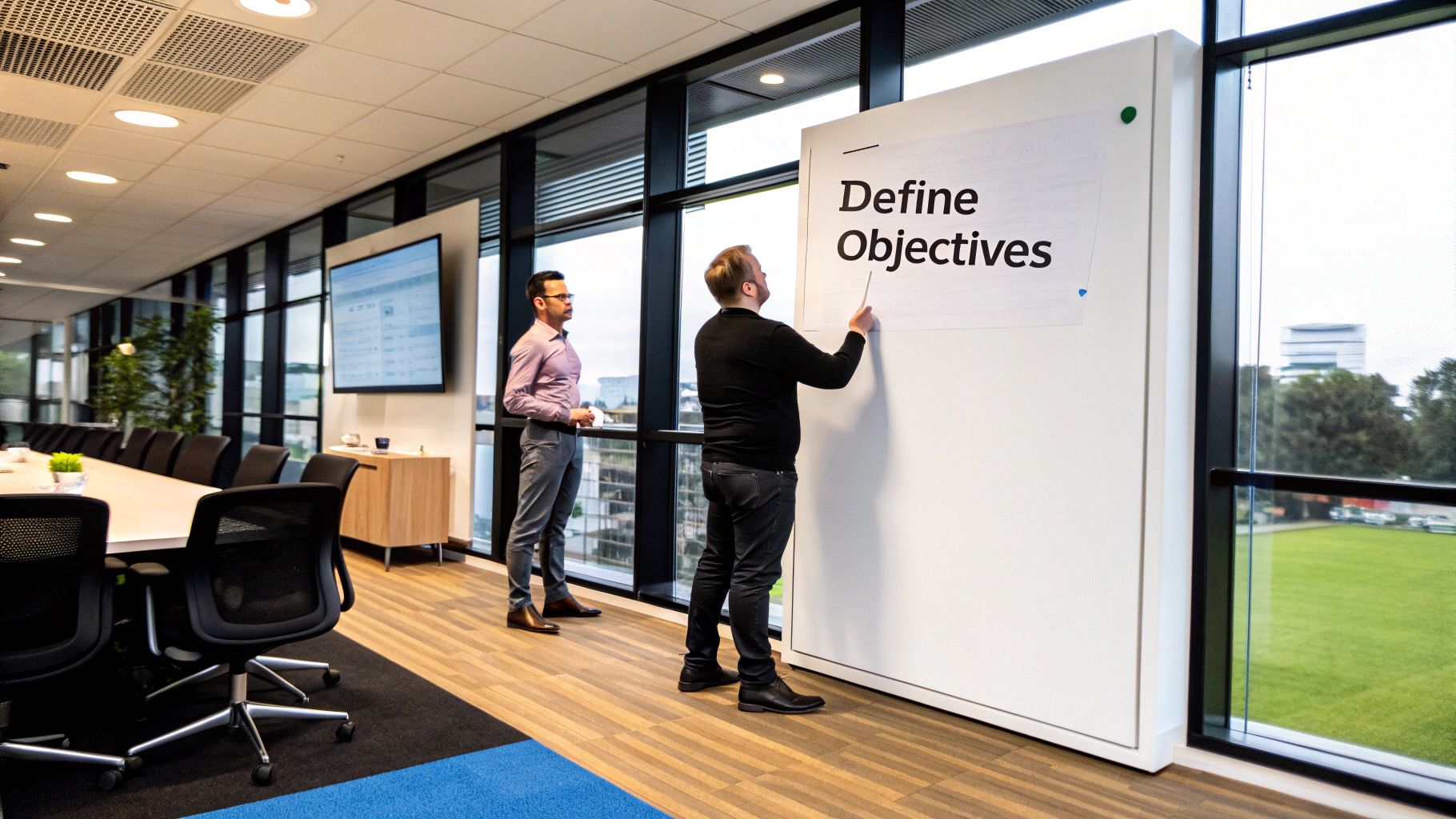
Imagine trying to build a house without an architectural plan. You could buy the best materials—high-quality bricks, sturdy lumber, and triple-pane windows. But if you start placing them randomly, you’d end up with a chaotic, unstable structure that serves no real function.
This is exactly what happens when businesses create content without a digital content strategy.
It might feel productive to publish sporadic blog posts or jump on trending social media videos, but without a plan, it’s just noise. For example, a local bakery might post a beautiful photo of a cake, but a strategic post would also include a question to drive engagement, relevant local hashtags to attract new customers, and a link to their online ordering page. A strategy provides the essential framework, tying every piece of content back to a larger business objective. It transforms your marketing efforts from an expense into a measurable asset that actually delivers a return.
Why a Strategy Is Non-Negotiable
A solid digital content strategy is critical because it forces you to answer the big questions before you ever write a single word or hit record on a video. It gives you direction, focus, and a clear path forward.
Here’s what a strategic approach brings to the table:
- Purposeful Creation: You stop making content just for the sake of it. Instead, you start producing assets designed to attract, engage, and convert a very specific audience. Every piece has a job to do. For instance, a blog post titled "5 Signs You Need a New Roof" is created specifically to attract homeowners with a problem your roofing company can solve.
- Resource Efficiency: It stops you from wasting time and money on content formats or channels that don’t connect with your ideal customers. This ensures you get the maximum impact from your investment. A B2B software company would wisely invest in detailed LinkedIn articles rather than spending its budget on Snapchat ads.
- Consistent Messaging: A strategy makes sure your brand voice, tone, and core messages are consistent everywhere, which builds trust and a recognizable brand identity.
- Measurable Growth: It establishes clear key performance indicators (KPIs), letting you track what works, what doesn't, and prove the real value of your content marketing.
A digital content strategy isn’t just about what you publish; it’s about architecting a customer journey. It ensures the blog post a prospect finds on Google logically connects to the webinar they sign up for, which then leads them to a targeted email offer.
Strategy vs. Tactics: What Is the Difference?
It's a common mistake: many businesses confuse strategy with tactics. They think a list of blog topics or a social media calendar is their strategy. In reality, those are just the individual actions—the bricks and windows in our house analogy.
The strategy is the overarching plan that dictates which bricks to use and where to place the windows for the best possible view. This table breaks it down.
| Aspect | Digital Content Strategy (The Blueprint) | Content Tactics (The Tools & Actions) |
|---|---|---|
| Focus | The why and who. Defines long-term goals and target audience. | The what and how. Specifies actions to achieve goals. |
| Example | Goal: "Become the go-to resource for franchise marketing." | Action: "Publish a weekly blog post on local SEO for franchisees." |
| Timeline | Long-term vision (12-24 months). | Short-term execution (daily, weekly, monthly). |
Ultimately, tactics without strategy are just aimless actions. To see how this high-level planning informs successful execution, it’s helpful to explore some essential content marketing best practices.
Understanding this distinction is the first step toward building a content program that doesn't just make noise, but builds a powerful, lasting brand.
The Core Pillars of Your Content Strategy
A powerful digital content strategy isn't something that just happens. It's built on a foundation of several key, interconnected pillars. Think of them like the support columns holding up a building—if one is weak, the whole structure gets wobbly. Nailing these core components gives you a framework that makes sure every piece of content is consistent, effective, and actually driving your business forward.
Each pillar answers a critical question: Who are you talking to? What do you sound like? What will you make? Where will you share it? And how will you know if any of it is working? Let’s break down these five essential elements.
Understanding Your Audience Personas
Before you write a single word or record a single video, you have to know exactly who you're creating it for. This goes so much deeper than basic demographics like age or location. A true audience persona gets into the head of your ideal customer—their motivations, their headaches, and their goals.
It’s the difference between saying, "we target marketing managers," and knowing, "we target Sarah, a 35-year-old marketing manager at a mid-sized tech company who’s struggling to prove campaign ROI and is desperately looking for data-driven solutions." That level of detail lets you create content that hits home because it speaks directly to her problems.
Practical Example: A Mini Persona
- Name: "Franchise Frank"
- Role: Owner of 3 quick-service restaurant franchises.
- Pain Points: Struggles with keeping local marketing consistent across his locations; feels overwhelmed by digital ad platforms; needs simple, repeatable marketing systems.
- Goals: Increase foot traffic by 20%; find marketing solutions that are easy for his store managers to implement.
Content for "Franchise Frank" would be all about practical guides, checklists for local marketing, and case studies from other franchise owners—not high-level, theoretical fluff.
Defining Your Brand Voice and Messaging
Your brand voice is the distinct personality your business shows the world through its content. Are you the formal, authoritative expert? The friendly, approachable guide? Or the witty, innovative thought leader? Whatever you choose, your voice has to be consistent everywhere to build a brand people recognize and trust.
Tied directly to this is your brand messaging—the core promise you make to your audience. It’s the simple answer to the question, "What problem do we solve better than anyone else?"
- Voice: How you say it (e.g., professional, casual, humorous). Insight: Mailchimp uses a friendly and encouraging voice, making complex marketing tech feel accessible to small businesses.
- Messaging: What you say (e.g., "We simplify local marketing for busy franchise owners"). Insight: Volvo’s core message has always been about safety, and all their content reinforces that single, powerful idea.
For an agency targeting small businesses, a helpful, clear, and encouraging voice is almost always going to be more effective than one loaded with confusing industry jargon.
Choosing Your Content Creation and Formats
Once you know your audience and your voice, you can figure out what you should actually create. The trick is to match the content format to your audience's habits and the topic's complexity. A digital content strategy isn't about being on every single platform; it's about being on the right platforms with the right formats.
- Blog Posts: Perfect for in-depth explanations, SEO, and showing you know your stuff.
- Videos: Great for tutorials, client testimonials, and putting a human face on your business.
- Podcasts: Ideal for busy professionals who consume content while commuting or multitasking.
- Infographics: Excellent for breaking down complex data into something easily shareable.
- Webinars: Best for generating leads and doing deep dives into specific, high-value topics.
A franchise owner like Frank would probably prefer a short, actionable video on setting up a Google Business Profile over a dense, 5,000-word article on the same topic.
Planning Your Content Distribution Channels
Making great content is only half the battle. The other half is getting it in front of the right eyeballs. Your distribution channels are the roads you use to deliver your content to your audience, so you need to know where they hang out online.
Common distribution channels include:
- Organic Search (SEO): Optimizing your content so it shows up in search engine results.
- Social Media: Sharing content on platforms like LinkedIn, Instagram, or Facebook where your audience is active.
- Email Marketing: Nurturing leads and keeping existing customers engaged through newsletters.
- Paid Advertising: Using platforms like Google Ads or Meta Ads to push your content to a highly targeted audience.
Your strategy should zero in on the one or two channels where you can make the biggest splash, rather than spreading your efforts too thin. For example, a law firm targeting corporate clients should focus heavily on SEO and LinkedIn, not Instagram.
Measuring Performance and KPIs
Finally, no content strategy is complete without a plan to measure what’s working. You absolutely have to define your Key Performance Indicators (KPIs) from the very beginning. These are the metrics that tell you if your content is actually hitting your business goals.
The infographic below shows a simple way to categorize your existing content based on performance, helping you decide what to keep, what to improve, and what to toss.
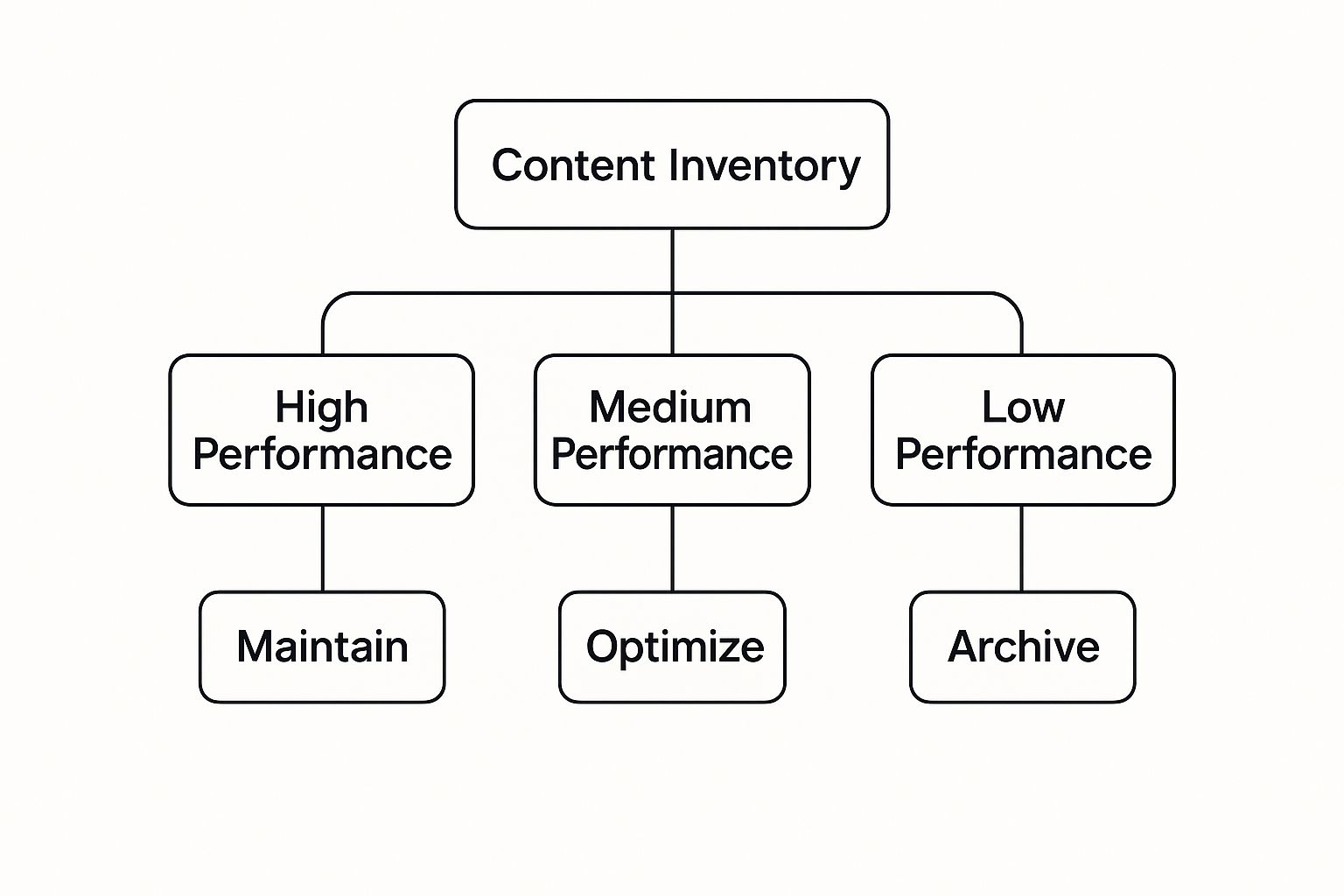
This hierarchy makes it clear: a content audit helps you systematically review your assets to keep what's working, optimize what has potential, and get rid of what no longer serves a purpose. Without tracking KPIs, you're just flying blind, unable to prove the value of your work or make smart, data-backed decisions to improve your strategy over time.
Using Social Media in Your Content Strategy
Social media used to be a digital bulletin board for company announcements. Those days are long gone. Today, it’s an essential, active channel for distribution, engagement, and community building that needs to be woven directly into your digital content strategy. Treating it as an afterthought is one of the biggest missed opportunities in modern marketing.
Think of social media as a powerful amplifier for your core messages. The goal is to move past the old "post and pray" approach where you just toss content out there and hope for the best. A real strategy means you're not just broadcasting, but starting valuable conversations. It all starts with figuring out where your audience actually spends their time and then tailoring what you say to fit the unique culture of each platform.
Choosing Platforms with Purpose
Not all social platforms are created equal, and your business definitely doesn't need to be everywhere. The real win comes from focusing your energy where it will have the most impact.
A B2B consultancy, for instance, will get far more traction discussing industry trends on LinkedIn than they would on TikTok. On the flip side, a local home services company can build a super-loyal following by showing off their work through visual stories on Instagram or Facebook.
To pick the right channels, ask yourself these questions:
- Audience Demographics: Where does your ideal customer, like "Franchise Frank," actually go for information and community?
- Content Format: Is your content visual and perfect for Instagram or Pinterest? Is it professional and better suited for LinkedIn? Or is it made for quick, engaging videos on TikTok or Reels?
- Business Goals: What are you trying to achieve? Brand awareness, lead generation, and customer support are all valid goals, but different platforms excel at different things.
A common mistake is just cross-posting the exact same message everywhere. A smart digital content strategy recognizes that a detailed, professional insight written for LinkedIn will completely fall flat as a quick Instagram caption. Every platform has its own language.
The power of social media skyrockets when it works in sync with your other marketing efforts. In fact, understanding how to combine SEO and social media for your marketing strategy is the key to creating a truly integrated digital presence where every channel lifts the others up.
Leveraging Influencers for Authentic Reach
Influencer partnerships are another piece of the puzzle. This isn't just about paying someone with a huge following for a quick shout-out. True strategic partnerships are about finding credible voices in your niche whose audience aligns perfectly with yours.
When you get this right, you build trust and introduce your brand to new, relevant communities in a way that feels genuine—not like a sales pitch. For example, a fitness apparel brand might partner with a local yoga instructor, not a mega-celebrity. The instructor's recommendation feels more authentic and directly reaches potential customers in the community. The right influencer can lend an authenticity to your content that traditional advertising just can't buy. For a complete guide to building out your presence, this social media marketing strategy playbook is an excellent resource.
This approach is backed by some serious trends. In 2025, the global social media ad market is projected to grow by 12%. Marketers are paying attention, with 59% planning to increase their use of influencer partnerships. Why? Because social content heavily sways the purchasing decisions of 76% of users—a figure that leaps to 90% for Gen Z, who now use social media as their go-to source for information.
Practical Example: A Local Service Business
Let's look at a local plumbing company. Instead of just running boring ads, they build a strategic presence on Instagram.
- Content: They create short, 15-second Reels showing their plumbers solving common problems, like fixing a leaky faucet or offering a quick tip on winterizing pipes.
- Strategy: They use local hashtags like
#DenverPlumberand#ColoradoHomesto get in front of homeowners in their actual service area. The content is genuinely helpful, positioning them as friendly, trustworthy experts. - Result: Homeowners see these practical tips and remember the company when a real plumbing emergency hits. This approach generates qualified local leads directly from social media, turning platform engagement into measurable business growth.
Optimizing Content for Search and Paid Ads
Creating brilliant content is a huge first step, but it’s completely wasted if the right people never see it. This is where your digital content strategy has to connect creation with discovery. We do that by focusing on the power couple of modern marketing: Search Engine Optimization (SEO) and paid advertising.
Think of it this way: without a plan to get eyeballs on your work, even the most insightful blog post or helpful video is like a billboard in the middle of the desert. It exists, but it’s not driving any business.

Driving Organic Traffic with Smart SEO
Good SEO isn't about stuffing keywords into your pages anymore. A modern, effective approach is all about understanding and satisfying user intent—the real "why" behind someone's search. Your goal is to become the most helpful, authoritative answer to the questions your audience is actually asking.
A powerful way to do this is by organizing your content into topic clusters. This strategy involves creating a central, comprehensive "pillar" page on a broad subject. Then, you link out from that pillar to several shorter, more specific "cluster" pages that dive deep into related subtopics. This structure signals to search engines like Google that you have serious expertise in that area.
Practical Example: SEO for a Local HVAC Company
A small HVAC business wants to compete with the big guys. Instead of targeting the super-competitive keyword "HVAC repair," their content strategy gets specific.
- Pillar Page: "The Ultimate Guide to Home AC Maintenance"
- Cluster Posts: "How to fix a leaking AC unit," "Signs you need to replace your air filter," and "Best thermostat settings for summer."
This approach helps them attract highly qualified traffic from people with very specific problems, making it much easier to rank and turn those visitors into actual leads. If you're looking for more ways to build your online presence, our guide on how to grow your business with SEO offers more actionable steps.
Aligning Content with Paid Advertising Campaigns
Your content is also the fuel for your paid ad campaigns. Every single part of a winning ad, from the headline that grabs attention to the landing page that converts, is a piece of content. And it all has to work together.
A strong strategy makes sure the user's journey is seamless, from the moment they click your ad to the second they become a customer. For instance, if you run a Facebook ad for "ergonomic office chairs," the landing page it links to must feature those exact chairs prominently, not your entire office furniture catalog. The ad copy has to perfectly match the message on the landing page, creating an experience that feels consistent and trustworthy.
This alignment is more critical than ever. The ad space is crowded, with worldwide digital ad spending projected to hit a staggering $740.3 billion by 2025. In the U.S., Google and Facebook dominate that spend, yet the average click-through rate for a Google search ad is just 3.17%. That tiny number shows just how compelling and optimized your content needs to be to stand out and deliver a positive return.
As we move into a world with fewer third-party cookies, your own high-quality content—your blog posts, guides, and videos—becomes your most valuable asset. It’s how you build a direct relationship with your audience, giving you the foundation for effective, privacy-friendly targeting and retargeting. Your content is the magnet, and your paid ads are simply the most direct road to it.
The Future of Content with Personalization and AI
The next frontier for your digital content strategy isn't about creating more content—it’s about creating smarter, hyper-relevant experiences for every single user. Let's be honest, the days of one-size-fits-all messaging are over. The future belongs to brands that can deliver the right message to the right person at the right time.
This is where personalization and artificial intelligence (AI) completely change the game. And no, these aren't some far-off, futuristic concepts. They are practical tools you can use right now to make your content more efficient, intelligent, and incredibly effective.
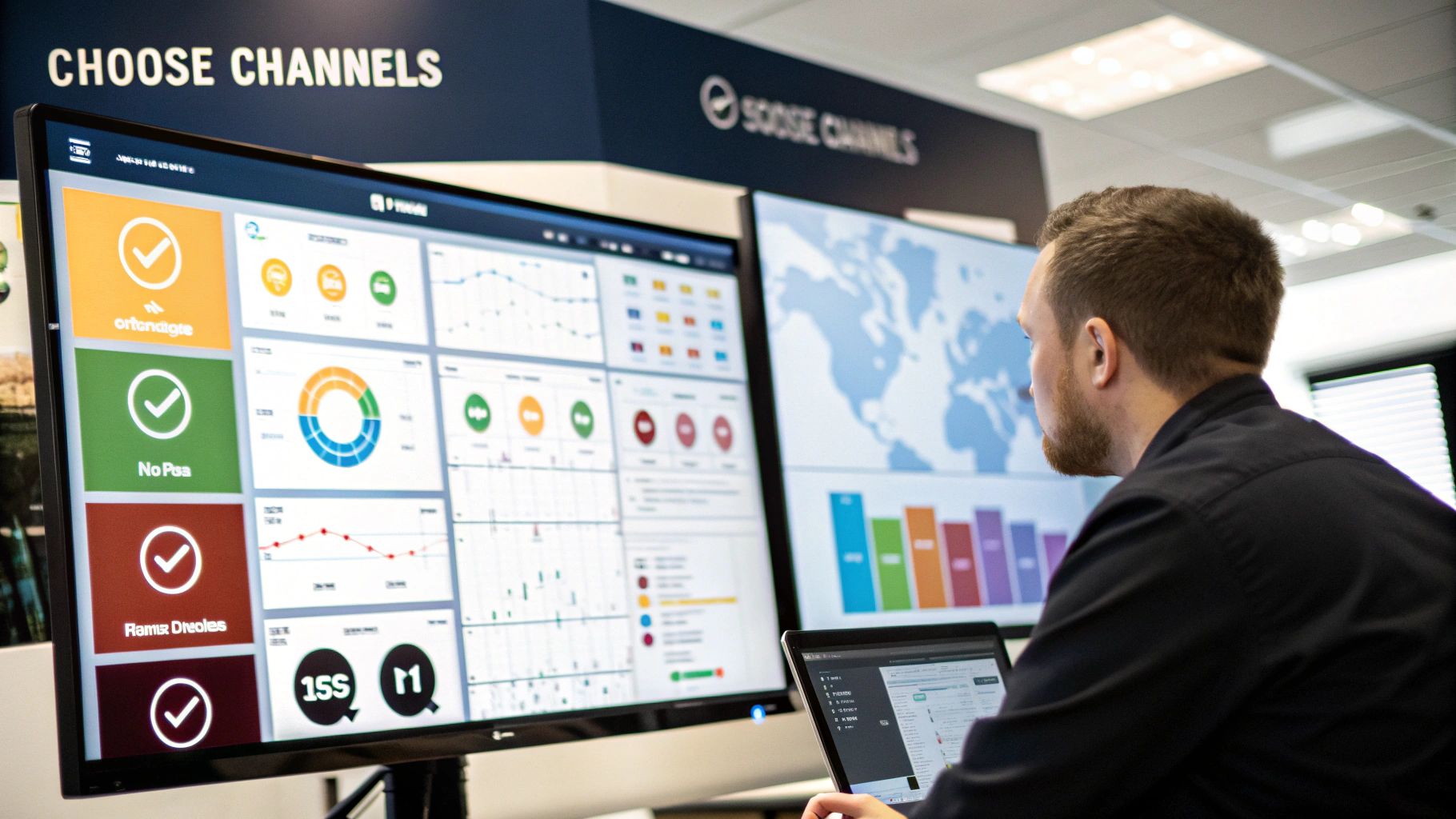
Beyond First Names to True Personalization
Real personalization goes way beyond just plugging a subscriber's first name into an email. True personalization is about creating dynamic experiences that adapt in real-time based on a user's behavior, their preferences, and their history with your brand.
Imagine a small business's e-commerce site. A brand-new visitor might see a homepage banner with a 10% discount for their first purchase. But a loyal customer who regularly buys gardening tools might see a banner promoting new organic fertilizers instead. That’s dynamic content in action. It recognizes who the user is and what they probably care about, making the whole experience feel less like a generic ad and more like a helpful conversation.
AI as Your Strategic Content Co-Pilot
Generative AI is quickly becoming an essential co-pilot for content teams. It’s not here to replace human creativity, but to supercharge it. Think of AI as a strategic partner that helps you produce higher-quality content, faster and at a much larger scale.
Here’s how AI can give your digital content strategy a serious boost:
- Brainstorming and Ideation: AI can chew through search trends and competitor content to spit out dozens of topic ideas, blog post outlines, and catchy headlines in minutes. A practical use: ask an AI tool, "What are the top 10 questions small business owners have about payroll?"
- Efficient First Drafts: Instead of staring at a blank page, your team can use AI to generate a solid first draft. From there, a human writer can step in to refine it, edit it, and inject your unique brand voice and expertise.
- Content Optimization at Scale: AI tools can scan your existing blog posts and suggest SEO improvements, from adding relevant keywords to making them more readable, helping you squeeze more value out of the content you already have.
The real power of AI isn't in pumping out soulless, generic articles. It's in handling the heavy lifting—the research, the structuring, the initial drafting—so your team can focus on high-level strategy, storytelling, and adding those authentic human insights that truly connect with your audience.
The business impact is impossible to ignore. The integration of generative AI is projected to create a revenue lift of around $10 billion by the end of 2024. At the same time, about 56% of marketing leaders are already investing heavily in personalization, because they know customers are more loyal to brands that make them feel understood.
These technologies are a huge shift, and understanding the future of digital marketing is crucial for any small business or franchise that wants to stay ahead. To really lean into this future, getting familiar with what different tools can do is a must. This comprehensive AI-powered writing assistant guide is a great place to start.
Your First 90 Days Content Strategy Roadmap
Turning theory into action can feel like the hardest part of building a digital content strategy. To cut through the overwhelm, I've laid out a practical 90-day roadmap broken down into three manageable phases. This is designed for small businesses or lean teams who need to build momentum without getting buried in complexity.
This step-by-step approach gets you from zero to a functioning content engine in just three months. Each phase builds on the last, ensuring you nail the fundamentals before you start creating.
Phase 1: Days 1-30 — Laying the Foundation
Your first month is all about planning. I've seen it a hundred times: businesses rush into creating content without a clear direction, and it's a surefire recipe for wasted time and money. Instead, this month is dedicated to the strategic groundwork that will guide every decision you make later.
Here are your core objectives for this phase:
- Set SMART Goals: Get specific about what success looks like. Instead of a vague goal like "get more traffic," aim for something like, "increase organic website traffic by 15% in the next quarter."
- Define Your Audience Persona: Don't try to talk to everyone. Go deep on one ideal customer. Give them a name, map out their biggest challenges, and figure out what truly motivates them. This clarity makes content creation infinitely easier.
- Conduct a Simple Content Audit: Take a look at what you already have. Identify what’s performed well in the past, what’s painfully outdated, and what hidden gems you can repurpose down the road. For example, find your top 3 most-visited blog posts from the last year and analyze what made them successful.
Think of this first phase as gathering your ingredients and reading the recipe before you start cooking. A little prep work now prevents a lot of chaos later and makes the final result so much better.
Phase 2: Days 31-60 — Creation and Distribution
Now that you have a plan, it's time to roll up your sleeves and start creating. The key here is to focus on quality and consistency, not quantity. Don't try to be everywhere at once; pick one or two channels where your audience actually hangs out and master them first.
During this month, your focus shifts to execution:
- Build a Simple Content Calendar: Plan out four to eight pieces of core content for the next 30 days. This could be four solid blog posts and the social media promotions to support them. Use a simple tool like Google Sheets or Trello to stay organized.
- Create Your First Content Pieces: Start writing, recording, or designing. Your only goal is to provide genuine value that directly addresses your persona's pain points.
- Establish a Distribution Rhythm: Begin sharing your content on your chosen channels. Consistency is far more important than frequency, so stick to a schedule you can realistically maintain.
Phase 3: Days 61-90 — Measure and Iterate
The final phase is all about learning and refining. Your digital content strategy isn't a "set it and forget it" document; it’s a living thing that should evolve based on real-world data. This is where you figure out what's actually working.
Your goal is to track a few simple, meaningful metrics and use that data to make smarter decisions moving forward. Look at Google Analytics to see which blog posts are getting the most traffic and which pages people leave from most often.
Actionable Tip: Work Smarter
Repurpose your core content to squeeze every last drop of value out of it. A single 1,000-word blog post can be transformed into:
- Five insightful social media posts with key takeaways.
- A short, engaging video script.
- An email newsletter summary.
- A visually appealing infographic.
This approach helps you fill your content calendar and reinforce your message across different touchpoints without starting from scratch every single time. By the end of these 90 days, you'll have a functioning, data-informed content strategy that's ready to scale.
Frequently Asked Questions
When you're digging into the world of digital content strategy, a few questions always seem to pop up. Let's tackle some of the most common ones we hear from business and franchise owners just like you.
How Often Should I Publish New Content?
The right answer isn't about hitting some magic number; it's all about consistency and quality. Honestly, it’s much better to publish one fantastic, well-researched blog post every two weeks than to churn out three so-so articles every week.
Find a schedule you can actually stick to. Whether that’s once a week or twice a month, that predictable rhythm builds trust with your audience and gives search engines fresh content to crawl on a regular basis.
How Do I Measure Content ROI?
To really prove your content is working, you have to look past the simple traffic numbers. The real return on your investment shows up in metrics that are tied directly to your business goals.
You'll want to keep a close eye on:
- Lead Quality: Are the people finding you through your content actually turning into paying customers? You can track this by asking "How did you hear about us?" on your contact forms.
- Conversion Rates: How many people who read a certain blog post go on to download your guide or fill out a contact form? Set up goals in Google Analytics to measure this automatically.
- Audience Engagement: Are people leaving comments, sharing your posts, and actually spending time on your pages?
These are the numbers that show how your content is actively making you money and helping you grow.
What Is the Difference Between a Strategy and a Plan?
Let's use a road trip analogy. The content strategy is your final destination and the reason you're even going—the "why." For instance, your strategy might be to become the most trusted resource for franchise marketing in the entire Midwest.
The content plan, on the other hand, is your turn-by-turn GPS—the "what" and "when." It’s the specific list of blog topics, social media posts, and videos you'll create each week to make sure you get to that destination. Your plan is how you execute your strategy.
At Latitude Park, we don't just talk about content—we build and execute powerful digital content strategies that drive real growth for franchises and small businesses. If you're ready to turn your content into a predictable engine for new customers, book a discovery call with us today.
